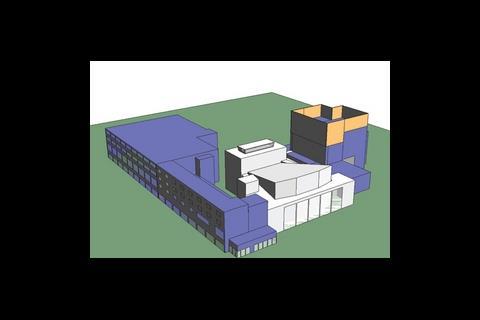Extensive computer modelling helped in choosing an environmental control system for Coventry’s refurbished Belgrade Theatre and its new performance space, BSj reports
It wasn’t just the leading man that had Coventry theatregoers swooning. Temperatures inside the Belgrade Theatre’s auditorium soared so high in summer that balcony seats could not be sold to the public.
Refurbishment of the 50-year-old venue, the first civic theatre to be built after the Second World War, provided the opportunity to correct the excessive highs – and lows – of the performance space. The 18-month project also provided a second, multipurpose, 200-seat auditorium, newly constructed with much-needed ancillary rehearsal space.
Existing auditorium
The proscenium theatre, with about 850 seats split between stalls and balcony, had mechanical ventilation, with air entering from architectural features on each side of the stage. The air was tempered in winter, with no cooling in summer. In addition, there was a number of warm-air convector heaters to the rear of the auditorium at each level.
The conditions endured by the audience can best be described as unpleasant. In winter, the auditorium was bitterly cold with the performers on stage and the audience suffering alike. This was not helped by the fact that the main get in – the access route for the set and equipment – was located at stage right, entering directly into the auditorium (now resolved as part of the work). There was massive uncontrolled infiltration in winter, to say nothing of the acoustic intrusion from traffic, particularly emergency services sirens. In summer, the reverse situation applied.
To add to the challenge for consulting engineer RYB:Konsult, the interior features of the auditorium were listed, leaving little scope for manoeuvre.
The first step was to develop a thermal model of the auditorium, using TaS software. The details of the existing ventilation plant were traced by site survey and the air volumes applied to the model to predict likely summer temperatures. The results surprisingly predicted temperatures exceeding 40ºC at balcony level, but the theatre staff confirmed that such excessive heat did occur, giving RYB: Konsult confidence in the model.
The next step was to apply varying volumes of supply air to the model, at differing temperatures, and to check the predicted temperatures. As previously noted, the supply air points into the auditorium were limited to the two existing ventilation openings by virtue of the listed interior, and therein lay the challenge. Too much air or too low a supply air temperature would overcool the stalls, while with insufficient air or too high a supply air temperature, the balcony would overheat.
RYB: Konsult undertook some 30 different thermal simulation runs once the computer model of the auditorium had been built. The air supply volumes were varied from the existing flow rate of 4.65 m³/s (which provided inadequate fresh air) up to 15 m³/s. This represented the maximum flow rate that RYB:Konsult estimated could be handled by the existing
builders-work air passages without acoustic problems. The air supply temperature was also varied between 12ºC and ambient conditions.
The optimum results were obtained with a supply air volume of 12.5 m³/s and a supply air temperature of 15ºC. This air volume gives a much-improved fresh air supply rate per person of 13 litres per second.
These modelling results were used as the base specification for the new air-handling plant and chillers installed as part of the works. A number of heavily attenuated and carefully specified extract fans was included at the rear of the auditorium and above the stage.
The inaugural performance in the refurbished auditorium took place on Friday, 7 September, with a packed house enjoying Humphrey Lyttelton and his jazz band.The new system coped admirably with the loads, and the audience reported that conditions were very comfortable.
New auditorium
The second performance venue is configured as a flat-floor multipurpose space, with a particular emphasis on drama. The seating capacity is 250-300.
RYB: Konsult briefly considered a displacement ventilation option but this was dropped in favour of an overhead supply system. This offers ultimate flexibility in terms of use of the area and did not require vertical riser space from the roof plant area.
The main concern with an overhead supply system is how to avoid acoustic problems when discharging air downward in heating mode. This scenario arises only in pre-heating mode, before the auditorium is occupied.
In the design, conditioned air is supplied into the auditorium from a system of high-level ductwork serving air diffusers within the structural zone above the technical gallery. The diffusers incorporate electric control actuators to allow the blade position to be adjusted remotely to accommodate both heating and cooling modes.
In addition, a number of the branch ducts incorporate shut-off dampers. In heating mode these will shut off the air supply to some of the diffusers. This will increase the air supply to the remaining diffusers, helping to throw the warm air into the occupied zone, against its natural buoyancy. Again, this will only occur in pre-heat mode before a performance. Once the auditorium has reached the correct temperature, normal control and air supply volumes will be resumed.
The fans are also speed controlled, based on temperature and CO2 levels, to minimise energy use during lower occupancy. Supplementary heating is provided by high-output convectors on the stage. This avoids the need to run the ventilation system during rehearsals.
Downloads
Original auditorium: chillers and fans added
Other, Size 0 kbNew venue: high-level ductwork for diffusers
Other, Size 0 kb
Source
Building Sustainable Design
Postscript
Original print headline: "Dramatic conclusion" (Building Services Journal, February 2008)

























